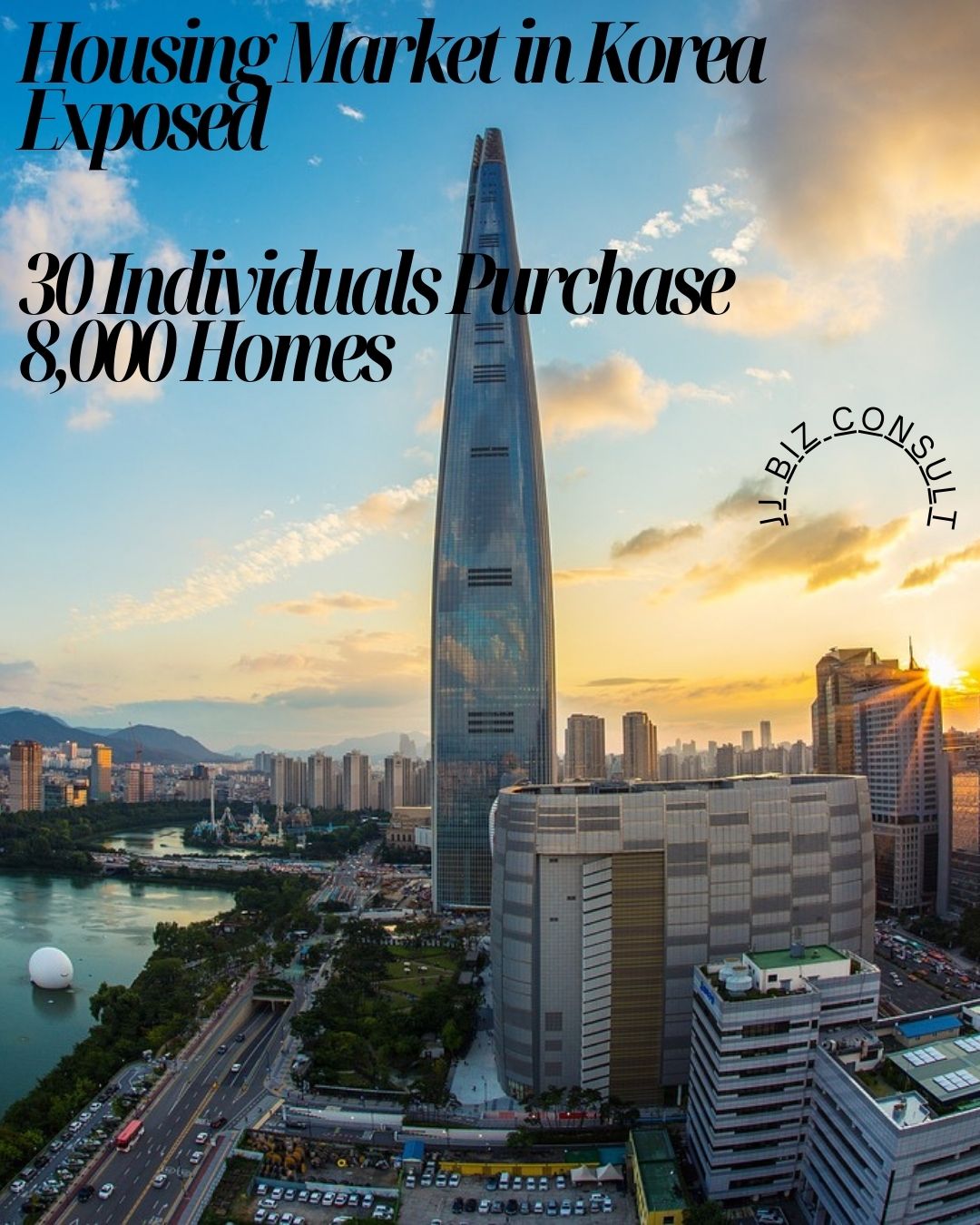Housing Market Korea Exposed: 30 Individuals Purchase 8,000 Homes

“Housing Market Korea Exposed: 30 Individuals Purchase 8,000 Homes Valued at $897 Million”
“Housing Market Korea Exposed: 30 Individuals Purchase 8,000 Homes Valued at $897 Million”
Introduction: Housing Market Korea Exposed
In a startling revelation, the fiercely competitive “Housing Market Korea” has been exposed, shedding light on the astonishing trend of 30 individuals collectively acquiring a staggering 8,000 homes over the past five and a half years. Compiled data by the Ministry of Land, Infrastructure, and Transport has unveiled that these purchases have a combined value of 1.19 trillion won (approximately $897.37 million). This shocking trend has raised concerns about the effectiveness of the government’s housing regulations in curbing house prices. In this blog post, we delve deeper into the details of this extraordinary phenomenon and its implications.
The Buying Spree
According to the data, 30 individuals have dominated the fiercely competitive “Housing Market Korea,” snapping up 7,996 properties from 2018 to June of the current year. The most prolific buyer in this group acquired a staggering 792 homes, amounting to a total value of 115.6 billion won. The second-largest buyer was not far behind, purchasing 709 homes with a total value of 115.1 billion won. These acquisitions encompassed a wide range of housing options, from apartments, the most popular choice in Korea, to less conventional low-rise multifamily residential complexes and detached homes.

Geographic Focus
Of the 30 buyers, 24 focused their purchases on homes located in Seoul, Incheon, and Gyeonggi Province, areas known for their high housing demand within the “Housing Market Korea.” This subgroup acquired a total of 6,622 homes, with a combined value of 1.45 trillion won. This geographic concentration highlights the growing disparity in housing opportunities across different regions of the country within the competitive “Housing Market Korea.”
Implications and Concerns
The revelation of these extensive property acquisitions has raised serious concerns within the government and the public at large, particularly within the context of the fiercely competitive “Housing Market Korea.” Rep. Min Hong-chul of the main opposition Democratic Party of Korea (DPK) and a member of the National Assembly’s Land, Infrastructure, and Transportation Committee, expressed skepticism about the government’s housing regulations, suggesting that they may not be effectively curbing land speculation and rising house prices within the “Housing Market Korea.”
Rep. Min also pointed out that these buying sprees may be attributed to certain deregulations in the greater Seoul area during the incumbent Yoon Suk Yeol administration. He called upon the government to prioritize policies that promote balanced regional development to address these alarming trends within the fiercely competitive “Housing Market Korea.”
In a startling revelation, the fiercely competitive “Housing Market Korea” has been exposed, shedding light on the astonishing trend of 30 individuals collectively acquiring a staggering 8,000 homes over the past five and a half years. Compiled data by the Ministry of Land, Infrastructure, and Transport has unveiled that these purchases have a combined value of 1.19 trillion won (approximately $897.37 million). This shocking trend has raised concerns about the effectiveness of the government’s housing regulations in curbing house prices. In this blog post, we delve deeper into the details of this extraordinary phenomenon and its implications.
The Buying Spree
According to the data, 30 individuals have dominated the fiercely competitive “Housing Market Korea,” snapping up 7,996 properties from 2018 to June of the current year. The most prolific buyer in this group acquired a staggering 792 homes, amounting to a total value of 115.6 billion won. The second-largest buyer was not far behind, purchasing 709 homes with a total value of 115.1 billion won. These acquisitions encompassed a wide range of housing options, from apartments, the most popular choice in Korea, to less conventional low-rise multifamily residential complexes and detached homes.

Geographic Focus
Of the 30 buyers, 24 focused their purchases on homes located in Seoul, Incheon, and Gyeonggi Province, areas known for their high housing demand within the “Housing Market Korea.” This subgroup acquired a total of 6,622 homes, with a combined value of 1.45 trillion won. This geographic concentration highlights the growing disparity in housing opportunities across different regions of the country within the competitive “Housing Market Korea.”
Implications and Concerns
The revelation of these extensive property acquisitions has raised serious concerns within the government and the public at large, particularly within the context of the fiercely competitive “Housing Market Korea.” Rep. Min Hong-chul of the main opposition Democratic Party of Korea (DPK) and a member of the National Assembly’s Land, Infrastructure, and Transportation Committee, expressed skepticism about the government’s housing regulations, suggesting that they may not be effectively curbing land speculation and rising house prices within the “Housing Market Korea.”
Rep. Min also pointed out that these buying sprees may be attributed to certain deregulations in the greater Seoul area during the incumbent Yoon Suk Yeol administration. He called upon the government to prioritize policies that promote balanced regional development to address these alarming trends within the fiercely competitive “Housing Market Korea.”
Source: The Korea Times
Housing Market Korea: Trends, Challenges, and Opportunities
The housing market in Korea has been undergoing significant changes in recent years, influenced by various economic, social, and political factors. In this blog post, we will explore some of the key trends, challenges, and opportunities that shape the current and future state of the housing market in Korea.
Housing Market Korea: Trends
One of the most notable trends in the Korean housing market is the rapid increase in house prices, especially in the capital city of Seoul and its surrounding areas. According to Kookmin Bank, the nationwide housing purchase price composite index surged 7.26% during the year to November 2020, its biggest year-on-year increase since October 2007. When adjusted for inflation, house prices rose by 6.6%. The average price of an apartment in Seoul reached 1.02 billion won (US$ 890,000) in August 2020, up 13.5% from a year earlier.
The main drivers of this price surge are the low interest rates, the high demand from young and middle-aged buyers, and the limited supply of new housing units. The Bank of Korea (BOK) lowered its policy rate to a record low of 0.5% in May 2020 to mitigate the economic impact of the COVID-19 pandemic. This stimulated the demand for mortgage loans, which increased by 9.7% year-on-year in November 2020. Many prospective homeowners sought loans at lower rates to purchase homes, a step many young Koreans generally see as necessary toward adulthood and future financial solvency. However, the supply of new housing units has not kept up with the demand, resulting in a housing shortage and a bidding war among buyers.
Another trend in the Korean housing market is the growing popularity of Jeonse, a unique rental system that involves paying a large lump-sum deposit instead of monthly rent. The deposit is usually equivalent to 50-80% of the property value and is returned to the tenant at the end of the lease term. Jeonse is attractive to both landlords and tenants, as landlords can earn interest from the deposit or invest it elsewhere, while tenants can save on rent and use the deposit as collateral for a mortgage loan when they decide to buy a home.
However, Jeonse is also facing some challenges, such as the rising deposit prices, the declining availability of Jeonse units, and the increasing cases of Jeonse deposit fraud. The average Jeonse deposit price in Seoul rose by 9.9% year-on-year in November 2020, reaching 517 million won (US$ 450,000). The supply of Japanese units has also decreased, as many landlords prefer to switch to monthly rent or sell their properties amid the rising house prices. Moreover, there have been several incidents of Jeonse deposit fraud, where landlords fail to return the deposit or use it for illegal purposes.

Housing Market Korea: Challenges
The Korean housing market is facing several challenges that may hamper its growth and stability in the near future. One of the main challenges is the high level of household debt, which reached a record high of 1,765 trillion won (US$ 1.54 trillion) in September 2020, accounting for 103.8% of GDP. About 70% of this debt is composed of mortgage loans. The high debt burden poses a risk to both households and financial institutions, especially if interest rates rise or income levels fall due to economic shocks or uncertainties.
Another challenge is the government’s intervention in the housing market through various tax and regulatory measures. The government has implemented several policies to curb speculation and cool down the overheated market, such as raising property taxes, imposing stricter lending rules, expanding public housing supply, and designating speculative zones where transactions are restricted or monitored. However, these policies have not been very effective in stabilizing house prices or improving affordability for low- and middle-income households. Instead, they have caused some unintended consequences, such as discouraging new construction, reducing market liquidity, and increasing social discontent among homeowners and renters.
A third challenge is the demographic change that affects the demand and supply of housing units. Korea has one of the lowest fertility rates and fastest aging populations in the world. The total population is expected to peak at 51.94 million in 2028 and decline thereafter. The number of households is also projected to peak at 23.24 million in 2035 and decrease afterward. These trends imply that the demand for housing units will decline in the long run, while the supply will increase as older homeowners sell or vacate their properties. This may lead to an oversupply of housing units and a downward pressure on house prices.
Housing Market Korea: Opportunities
Despite the challenges, the Korean housing market also offers some opportunities for growth and innovation. One of the opportunities is the development of smart and green housing, which incorporates advanced technologies and environmental features to enhance the quality and efficiency of living. Smart housing refers to housing that uses information and communication technologies (ICT) to provide various services and functions, such as security, energy management, entertainment, health care, and education. Green housing refers to housing that minimizes the environmental impact and maximizes the energy efficiency of the building and its surroundings.
The demand for smart and green housing is expected to increase in the future, as more consumers become aware of the benefits and convenience of these features. The government is also supporting the development of smart and green housing through various policies and programs, such as providing subsidies, tax incentives, and certification systems. Moreover, the COVID-19 pandemic has accelerated the adoption of smart and green housing, as more people spend time at home and seek safer and healthier living environments.
Another opportunity is the diversification of housing types and tenures, which can cater to the different needs and preferences of various segments of the population. The Korean housing market has been dominated by apartments and jeonse for a long time, but there is a growing demand for alternative options, such as detached houses, row houses, studio apartments, co-living spaces, monthly rent, and shared ownership. These options can provide more choices and flexibility for consumers, as well as more opportunities for developers and investors.
The government is also promoting the diversification of housing types and tenures through various policies and programs, such as easing zoning regulations, providing subsidies, creating pilot projects, and encouraging public-private partnerships. Furthermore, the demographic change and the social change that accompany it may also stimulate the demand for diverse housing options, as more people seek housing that suits their lifestyle, income level, family size, and life stage.
Conclusion
The housing market in Korea is a dynamic and complex sector that reflects the economic, social, and political conditions of the country. It has experienced significant growth and transformation in recent years, but it also faces some challenges and uncertainties that may affect its future performance. However, it also offers some opportunities for innovation and development that can enhance the quality and sustainability of living. Therefore, it is important to monitor the trends, challenges, and opportunities in the Korean housing market and to adapt to the changing environment accordingly.
Social Media Marketing Trends 2024: A Review of the Essential Guide to Stay Ahead of the Curve





